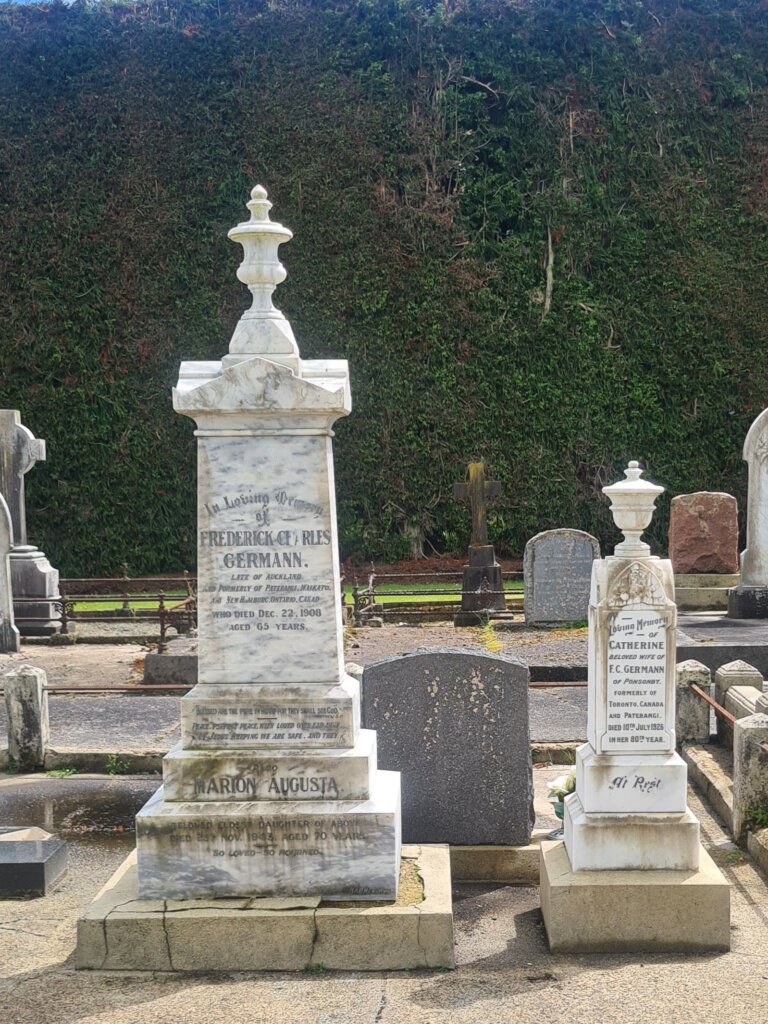To keep young Catherine Scott and Frederick Germann apart, Catherine’s father took the extreme measure of moving his entire family from Canada all the way to Paterangi, New Zealand.
It was 1867 and Scotsman William Scott, the founder of New Hamburg, Canada, would not have his daughter involved with one of his estate field hands. Scott, with a long list of achievements to his name, was left reeling after his wife died. He sold up everything and walked away from a prosperous future in Canada, appearing to direct most of his grief-stricken rage at Catherine. He also told her siblings they would be disinherited if they ever returned to Canada.

Frederick and Catherine are buried side by side at Paterangi.
On arriving in New Zealand, after a short time spent in Auckland, the family journeyed to Te Awamutu, a trip which took them a week. In 1871 William relented and allowed 28-year-old Frederick to come to New Zealand and marry Catherine, 25, at the Scott’s Paterangi residence.
In the years since the Scott family’s departure from Canada Frederick had worked as a bank keeper and a merchant. Whatever disapproval William Scott may have had of Frederick, his new son-in-law would go on to more than prove himself.
He and Catherine lived at their Paterangi property, ‘Fernie Bank’, and were to have six children. Frederick took a prominent part in local affairs, becoming a member Mangapiko Highway Board and the Waipā County Council. He was known as upright and a man of integrity, earning him the respect of all.
He was active in farming matters and introduced the successful farmers’ mutual fire insurance scheme. He was with the Paterangi Football Club since its foundation, and was also a member of the cricket and lacrosse clubs, his keen interest in sport making him a favourite with the younger generation.
The energetic Frederick also took a leading part in an attempt to establish freezing works in Ōhaupō and was involved in arranging for the main telegraph line between Auckland and the
terminus at Ōhaupō to be erected. Somehow, he also found time to write regular contributions for the Waikato Argus and become a well-known player in Waikato chess circles.
Catherine and Frederick had a full and active life in Paterangi but by 1907, when Frederick was 64, they moved to Auckland.
Before they left, the Paterangi Football club held a social to farewell the Germann’s. Despite the wet weather, there was a large attendance from all parts of the district. There were toasts and speeches and Frederick, rising to respond, was greeted with cheers. He was presented with a beautiful personally inscribed ivory-handled ebony walking-stick, a gift which took him entirely by surprise.
Two years later, while on the Grey Lynn bowling green, Fredrick suffered a stroke. He was transported home where he died. Frederick was taken back to Paterangi by train, the funeral leaving from the Nga Roto railway station. The reverend enlarged upon the good qualities of Frederick and held his life up as an example to be followed.
His beloved Catherine lived another 18 years. She died aged 80. They are buried next to each









